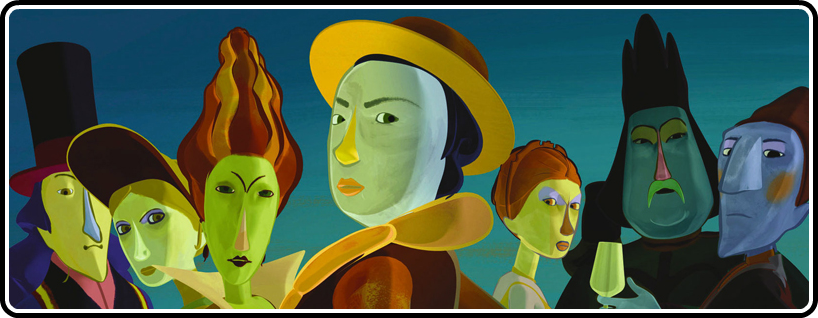
The opening of Jean-François Laguionie’s animated film, which takes place inside the idiosyncratic personality of a populated painting, is like a fairy tale. Instead of starting with the image of an opening book, inviting us into the story a la Disney, we see the ornate gilt frame of a painting and then slowly zoom inside of it. The painting bursts with impressionistic colors of all kinds.
Our narrator is Lola; she is a major player in The Painting and also a ‘Halfie’. What does this mean, you ask? You see, the titular painting in question was never quite finished, leaving three classes or races of people, which could be read as an abstract representation of any number of conflicts. The ‘Alldunn’s’ are the upper-class, completely finished and haughtily elite, living high up in a grand estate. The Halfies are incomplete (one woman is merely missing the color in a corner of her skirt), living together in the wild. Roma (an Alldunn) and Claire (a Halfie) are in love but cannot be together.
The ‘Sketchies’ have it the worst. They are what their name suggests; mere scribbles who can barely finish their sentences, the lowest of the low. So low to the Alldunn’s in fact, that they’d like to wipe the ‘Sketchies’ from existence. In one early scene that took me by surprise in its cruelty (up until then I had thought of the Alldunn’s superiority complex as akin to “The Sneetches”), the elite literally stomp a Sketchie named Gum out of existence. The story gets into gear once Roma, Lola and a ‘Sketchie’ named Quill end up on the run, into the supposedly dangerous forest. This begins a journey beyond the world of the painting, into other paintings and the artist’s studio as they try to find their Creator.
The groundwork concepts and accompanying animation truly stand out. Putting the painter in the Creator/God position makes the artist all-powerful and appropriately elusive. The characters, especially Lola, have a natural curiosity and want to know more about him. There’s a nice touch where they get the chance to talk to a self-portrait of the artist. Just as the characters explore the world beyond their own, there’s a parallel exploration of the artist and the independent life his/her creations inhabit by their mere existence. Art lovers will be, forgive the pun, particularly drawn to the film. It also links art and creation to questions of identity and acceptance that kids will be cued enough to pick up on. In fact, this is a great film for kids for its level of imagination, adventurous spirit and color.
Beyond that, The Painting never quite gets off the ground the way it should as a story, steadily losing steam in its final half though it is somewhat upheld by its ideas. The only complaint regarding the animation is that the characters’ faces are inexpressive and stiff; a considerable damper because every character is broad at best. The flat characters assist the film as parable but fail it as a consistently engaging work. The Alldunn’s are introduced and then largely forgotten while the climax made me realize I did not care much what happened to these painted explorers and lovers. The story lacks nuance and it shows. It is a film carried through by its ideas and visual palette and in this case that is enough.
Full Schedule for the 2013 Portland International Film Festival
The Painting will be shown at the Whitsell Auditorium on Sunday, February 17th, 2013 (5:30 p.m.) For details and more information



![Bergman Island (The Criterion Collection) [Blu-ray]](https://criterioncast.com/wp-content/uploads/2022/11/bergman-island-the-criterion-collection-blu-ray-400x496.jpg)
![This Is Not a Burial, It’s a Resurrection (The Criterion Collection) [Blu-ray]](https://criterioncast.com/wp-content/uploads/2022/11/this-is-not-a-burial-its-a-resurrection-the-criterion-collection-blu-ray-400x496.jpg)
![Lars von Trier's Europe Trilogy (The Criterion Collection) [The Element of Crime/Epidemic/Europa] [Blu-ray]](https://criterioncast.com/wp-content/uploads/2022/11/lars-von-triers-europe-trilogy-the-criterion-collection-the-element-of-400x496.jpg)
![Imitation of Life (The Criterion Collection) [Blu-ray]](https://criterioncast.com/wp-content/uploads/2022/11/imitation-of-life-the-criterion-collection-blu-ray-400x496.jpg)
![The Adventures of Baron Munchausen (The Criterion Collection) [4K UHD]](https://criterioncast.com/wp-content/uploads/2022/11/the-adventures-of-baron-munchausen-the-criterion-collection-4k-uhd-400x496.jpg)
![Cooley High [Criterion Collection] [Blu-ray] [1975]](https://criterioncast.com/wp-content/uploads/2022/11/cooley-high-criterion-collection-blu-ray-1975-400x496.jpg)